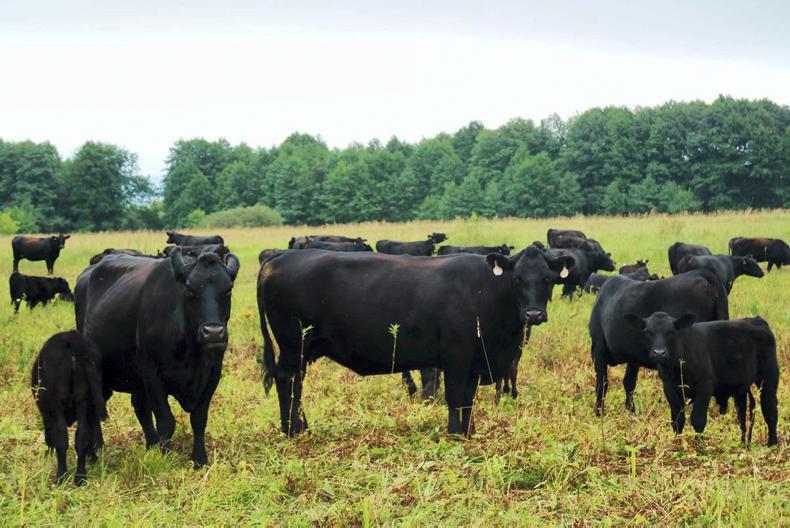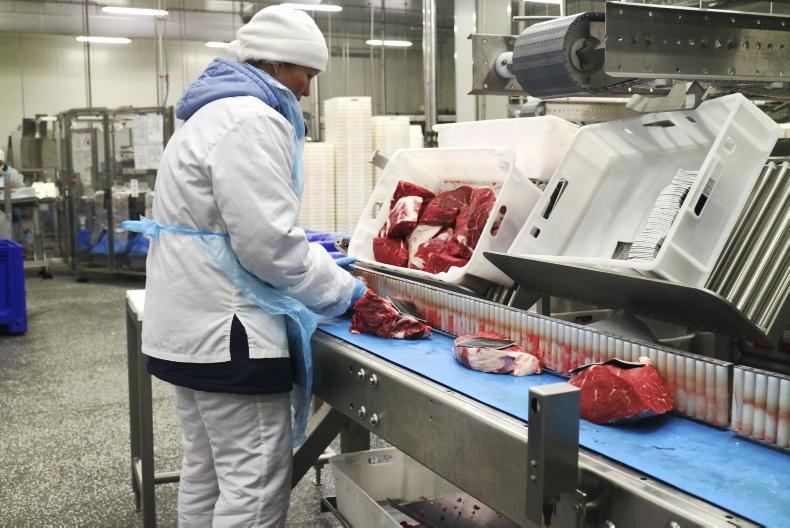Russia’s total land area is 17,100,000 km2 – the island of Ireland could fit within its border over 200 times.
Of this area, 45% is forested. For perspective, it’s the equivalent to Co Cork, 1,000 times.
15% of Russia’s area can be described as tillable pasture land.
It is estimated that there are just 540,000 dedicated beef cows in Russia. There is almost twice this in Ireland, but remember that we export over 90% of the beef that we produce each year and that the Russian dairy herd is 10 times greater than Ireland’s and a source of beef too.
Average annual income in Russia this year will be around €5,000.
Beef consumption is hovering around 12kg per capita annually – half what the average American consumes (we eat 19kg here in Ireland). Indeed, chicken is twice as popular. However, in rural Russia, beef is typically ground up, eaten in a broth or boiled and likely to have come from cull dairy cows. It is really only seen as a luxury meal – steak/hamburgers – in urban areas.
The smaller farmers I toured were producing two-year-old bulls for slaughter at a liveweight just shy of 500kg. These animals were Angus-sired, out of Kalmyk-cross cows. This is a native Mongolian breed known to be extremely robust, and it needs to be extremely robust.
During winter, temperatures consistently reach -30°C. In their native Mongolia, these Kalmyk cows are often outwintered. They have a mature weight of less than 450kg and are slow growing, hence the Angus cross. In the summer, temperatures climb as high as 30-35°C.

To support a family, a Russian beef ranch needs to be around 200 hectares.
There is no grading or age specifications in place when selling animals to the factory in Russia thus far. Weight is the main criteria and it is a minimum, rather than a maximum weight cap. While Angus is sought after, there is no registration or traceability, so a black or red hide is enough to be considered Angus.
Animals are bought live by processors, with rates of 128rubles/kg (€1.83/kg liveweight) being achieved at present.
While there are no direct payments as in the EU, agriculture is well supported. Russia is split into 46 Oblasts (districts) and each has a government with an agriculture budget. Purchase subsidies are common, whereby a farmer can buy cattle and receive some of his money back from the government. Oblasts compete with each other and this is a way of them boosting their own cattle inventories. There are some conditions with the subsidies: animals must be retained for three years, quarantined on both the seller and buyer’s farm and be signed off on by a vet.
One of the overwhelming characteristics of rural Russia is the sparseness and lack of activity. In the population density league table, Russia is 19 from the bottom out of 218 countries. It has eight people per km2, Ireland has 69. There is an abundance of top quality land. Soils are good and there are around 53mm of rain per month in Tambov, Penza and Bryansk. Land is quite readily available, with good quality cropping land selling for €400/ha and abandoned land on good soil for as little as €25. There’s a caveat with the latter though. This land will likely have been abandoned since Soviet times and covered in trees at this point – investment will be needed to fell these so that cattle can graze..
A 400-cow beef herd manager in Tambov, with a 15-strong workforce, can earn around €8,600 annually. Not a lot?
A 500ml bottle of beer in a rural town will cost 50 cents.A four-hour, 400km train journey costs €17.An abandoned bungalow in a rural village costs €5,000.A two-course meal with coffee and a beer costs €14 in Moscow cafes.There is huge variation between cost of living in the city and countryside, of course. Salaries in Moscow can be twice that of country workers.

Miratorg, Russia’s largest meat producer, has around 200,000 beef cows on its books.
Miratorg’s slaughter plant near Bryansk can process 10,000 animals a week. It is currently running at 20% of capacity, but plans to reach its peak in 2021 – Russia will have become a huge player on the global beef market in a very short period if this does materialise.
A tonne of dry rolled wheat can be bought for the equivalent €74 in the regions south of Moscow. However, beware of the hidden logistical costs. Distances in Russia are so big, that transport costs per tonne can sometimes be similar to the cost of the actual grain.
Read more
The accidental Russian beef tycoon from Alabama
Russia’s total land area is 17,100,000 km2 – the island of Ireland could fit within its border over 200 times.
Of this area, 45% is forested. For perspective, it’s the equivalent to Co Cork, 1,000 times.
15% of Russia’s area can be described as tillable pasture land.
It is estimated that there are just 540,000 dedicated beef cows in Russia. There is almost twice this in Ireland, but remember that we export over 90% of the beef that we produce each year and that the Russian dairy herd is 10 times greater than Ireland’s and a source of beef too.
Average annual income in Russia this year will be around €5,000.
Beef consumption is hovering around 12kg per capita annually – half what the average American consumes (we eat 19kg here in Ireland). Indeed, chicken is twice as popular. However, in rural Russia, beef is typically ground up, eaten in a broth or boiled and likely to have come from cull dairy cows. It is really only seen as a luxury meal – steak/hamburgers – in urban areas.
The smaller farmers I toured were producing two-year-old bulls for slaughter at a liveweight just shy of 500kg. These animals were Angus-sired, out of Kalmyk-cross cows. This is a native Mongolian breed known to be extremely robust, and it needs to be extremely robust.
During winter, temperatures consistently reach -30°C. In their native Mongolia, these Kalmyk cows are often outwintered. They have a mature weight of less than 450kg and are slow growing, hence the Angus cross. In the summer, temperatures climb as high as 30-35°C.

To support a family, a Russian beef ranch needs to be around 200 hectares.
There is no grading or age specifications in place when selling animals to the factory in Russia thus far. Weight is the main criteria and it is a minimum, rather than a maximum weight cap. While Angus is sought after, there is no registration or traceability, so a black or red hide is enough to be considered Angus.
Animals are bought live by processors, with rates of 128rubles/kg (€1.83/kg liveweight) being achieved at present.
While there are no direct payments as in the EU, agriculture is well supported. Russia is split into 46 Oblasts (districts) and each has a government with an agriculture budget. Purchase subsidies are common, whereby a farmer can buy cattle and receive some of his money back from the government. Oblasts compete with each other and this is a way of them boosting their own cattle inventories. There are some conditions with the subsidies: animals must be retained for three years, quarantined on both the seller and buyer’s farm and be signed off on by a vet.
One of the overwhelming characteristics of rural Russia is the sparseness and lack of activity. In the population density league table, Russia is 19 from the bottom out of 218 countries. It has eight people per km2, Ireland has 69. There is an abundance of top quality land. Soils are good and there are around 53mm of rain per month in Tambov, Penza and Bryansk. Land is quite readily available, with good quality cropping land selling for €400/ha and abandoned land on good soil for as little as €25. There’s a caveat with the latter though. This land will likely have been abandoned since Soviet times and covered in trees at this point – investment will be needed to fell these so that cattle can graze..
A 400-cow beef herd manager in Tambov, with a 15-strong workforce, can earn around €8,600 annually. Not a lot?
A 500ml bottle of beer in a rural town will cost 50 cents.A four-hour, 400km train journey costs €17.An abandoned bungalow in a rural village costs €5,000.A two-course meal with coffee and a beer costs €14 in Moscow cafes.There is huge variation between cost of living in the city and countryside, of course. Salaries in Moscow can be twice that of country workers.

Miratorg, Russia’s largest meat producer, has around 200,000 beef cows on its books.
Miratorg’s slaughter plant near Bryansk can process 10,000 animals a week. It is currently running at 20% of capacity, but plans to reach its peak in 2021 – Russia will have become a huge player on the global beef market in a very short period if this does materialise.
A tonne of dry rolled wheat can be bought for the equivalent €74 in the regions south of Moscow. However, beware of the hidden logistical costs. Distances in Russia are so big, that transport costs per tonne can sometimes be similar to the cost of the actual grain.
Read more
The accidental Russian beef tycoon from Alabama








 This is a subscriber-only article
This is a subscriber-only article











SHARING OPTIONS: